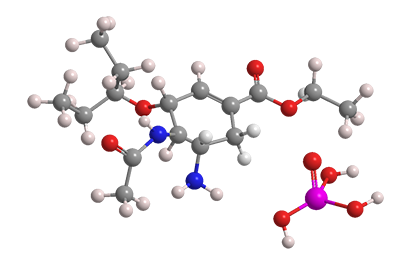What molecule am I?


The 2017–2018 flu season is seeing record numbers of cases, hospitalizations, and pediatric deaths. Oseltamivir phosphate (usually shortened to oseltamivir), a prescription drug used to prevent and treat influenza, is in high demand. Best known by its trade name Tamiflu, it can be effective against influenza A and influenza B, which are genera of the Orthomyxoviridae virus family.
Oseltamivir, even when it does work, reduces the duration of flu symptoms by only 12–24 h. Some people take it prophylactically, but the US Centers for Disease Control and Prevention does not recommend this practice because it may cause the viruses to develop resistance to the drug. The exception is that high-risk individuals should take it if they have not been (or have only recently been) vaccinated and have been exposed to flu in the previous 48 h.
The irony is that many, if not most, high-risk people are more than 65 years old. But oseltamivir does not work as well in seniors as it does with younger people.
Oseltamivir phosphate hazard information
| Serious eye damage/eye irritation, category 2A | |
| H319—Causes serious eye irritation | |
| GHS classification: skin sensitization, category 1 | |
| H317— May cause an allergic skin reaction | |
| GHS classification: hazardous to the aquatic environment, category 3 | |
| H412— Harmful to aquatic life with long-lasting effects | |
*Globally Harmonized System of Classification and Labeling of Chemicals. Explanation of pictograms.
Oseltamivir phosphate
fast facts
| CAS Reg. No. | 204255-11-8 |
| Molar mass | 410.40 g/mol |
| Empirical formula | C16H28N2O4•H3O4P |
| Appearance | White crystals |
| Melting point | 190–206 ºC* |
| Water solubility | 1.6 g/L (est) |
*Wide range of reported melting points
MOTW update
Perfluorooctanoic acid (PFOA) was the Molecule of the Week for August 10, 2015. It is widely used in the production of polytetrafluoroethylene (Teflon) and microchips, but it is being phased out because it is a significant contaminant in drinking water.
In 2010, DuPont introduced GenX, another perfluorinated surfactant, as a “sustainable” replacement for PFOA. But water in the river downstream from the Fayetteville, NC, plant where Nemours (DuPont’s successor) manufactures GenX is contaminated with fluorochemicals. Even after Nemours began to collect its wastewater for disposal in a deep injection well in Texas, perfluorinated ethers such as GenX are mysteriously being detected in the river.

Learn more about this molecule from CAS, the most authoritative and comprehensive source for chemical information.
Molecule of the Week needs your suggestions!
If your favorite molecule is not in our archive, please send us a message. The molecule can be notable for its current or historical importance or for any quirky reason. Thank you!
Stay Ahead of the Chemistry Curve
Learn how ACS can help you stay ahead in the world of chemistry.

